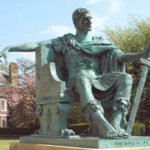 He ordered his eldest son, his nephew, and his second wife put to death. He tortured, murdered and imprisoned anyone, including cousins and former friends, known or suspected of being political rivals. He issued an edict on religious freedom for all in his dominions yet dismantled temples and looted their treasuries. He proclaimed himself a follower of the Prince of Peace, yet his path to undisputed power was littered with battles, great and small.
He ordered his eldest son, his nephew, and his second wife put to death. He tortured, murdered and imprisoned anyone, including cousins and former friends, known or suspected of being political rivals. He issued an edict on religious freedom for all in his dominions yet dismantled temples and looted their treasuries. He proclaimed himself a follower of the Prince of Peace, yet his path to undisputed power was littered with battles, great and small.
He was called Constantine the Great, and for centuries historians and church leaders have been divided as to the motives for his embrace and eventual conversion to Christianity. Theories on why Constantine abandoned the Roman pantheon of gods have ranged from conspiracy with bishops inside the nascent Christian community to guilt over the murder of his son. But there is agreement that this ruthless empire builder of late antiquity was the single most influential force in the spread of the faith. Through a twist of fate, this ruler who warred and willed the Roman Empire back together, laid the groundwork for the rise of Christendom.
A Vision and A Bridge
Though the story handed down has been deemed truth by some and legend by others, there is general agreement that Constantine attributed the defeat of Maxentius, ruler of Rome, to an experience directed by the Christian God. The legend goes that on the eve of a battle near the Miluvian Bridge on the Tiber River near Rome, Constantine saw a cross of light in the sky above the sun. Around the cross appeared the words, ‘In hoc signo vinces,’ which means, “By this, conquer.” That night, Christ appeared to him in a dream and urged him to make a copy of what he’d seen. The next morning Constantine summoned a goldsmith and had a large cross-fashioned to carry into the fight against Maxentius.
Despite his troops being outnumbered, Constantine prevailed that day. While retreating across the bridge, Maxentius and hundreds of his troops were plunged into the swirling currents of the Tiber when the structure collapsed. They swiftly sank to the bottom dragged down by the weight of their armor. Thus began Constantine’s alliance with Christianity though he would not formally convert until he was on his deathbed 25 years later.
A Savvy Strategy
Considered a minor religion, Christians comprised less than ten percent of the population subject to Constantine’s rule. Realizing that forced conversion would be impractical, the strategy employed by the sovereign to promote the marginal practice included such ploys as exempting clergy from taxes, stripping pagan temples of their costly furnishings, and ornaments, banning blood sacrifices and statues of the emperor, and incorporating Christian symbols into the public spaces and architecture of his new capital city, Constantinople. He wrote an open letter to the people of Palestine, and embedded the sign of the cross in the equipment and arms used by his troops. Constantine made it clear that Christianity was his religion of choice.
Lasting Impact
By the time of his death in 337 A.D., Constantine the Great had bishops as a trusted part of the imperial entourage and Christian language, symbols and rituals became part of the vocabulary of imperial power. A mere forty years earlier, Roman  authorities had launched a systematic assault to suppress Christianity. It was a time referred to by members of that community as the “Great Persecution.”
authorities had launched a systematic assault to suppress Christianity. It was a time referred to by members of that community as the “Great Persecution.”
There is little dispute among modern historians and religious scholars that without the financial subsidies and generous support of Constantine, Christianity would have remained a minor faith practice on the fringes of the Mediterranean world. It was the Emperor’s assistance that marked a fundamental turning point in the destiny of the Christian church and the European state. The world would never be the same.

